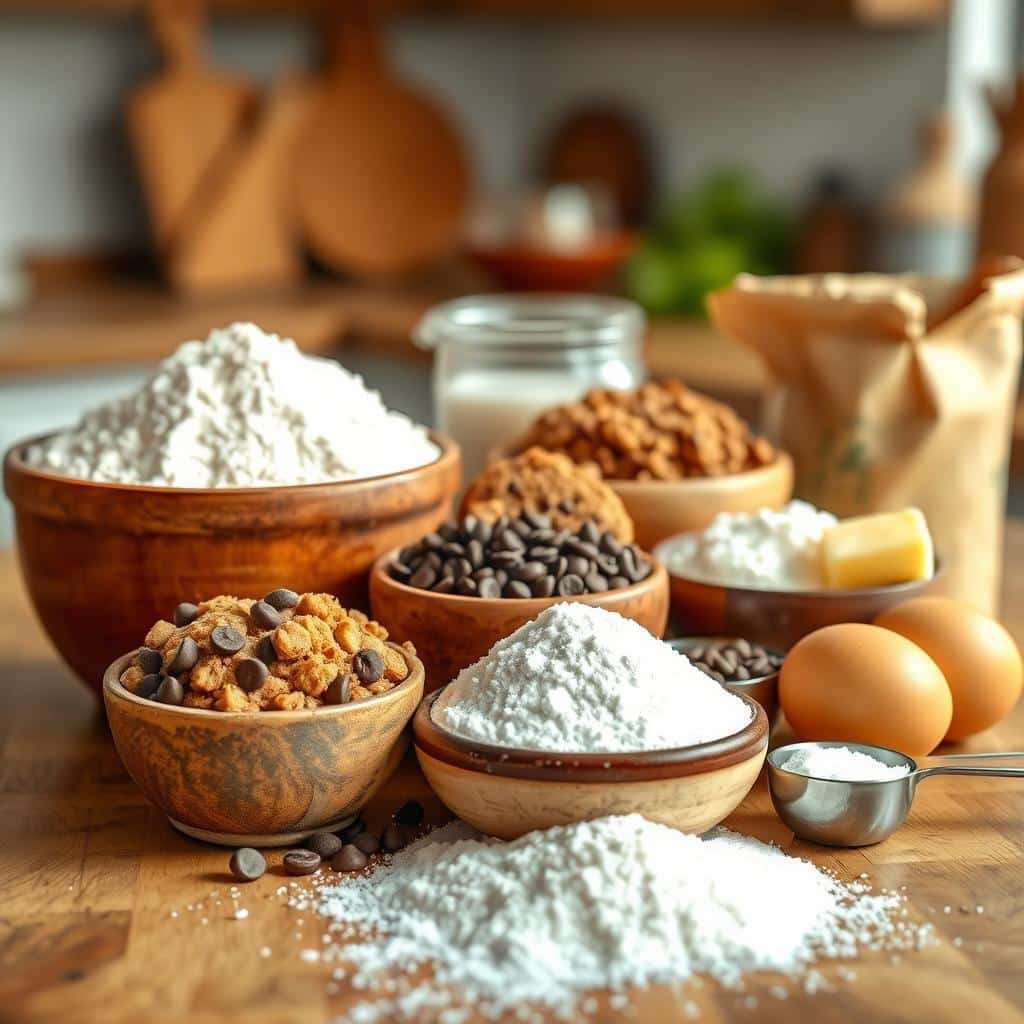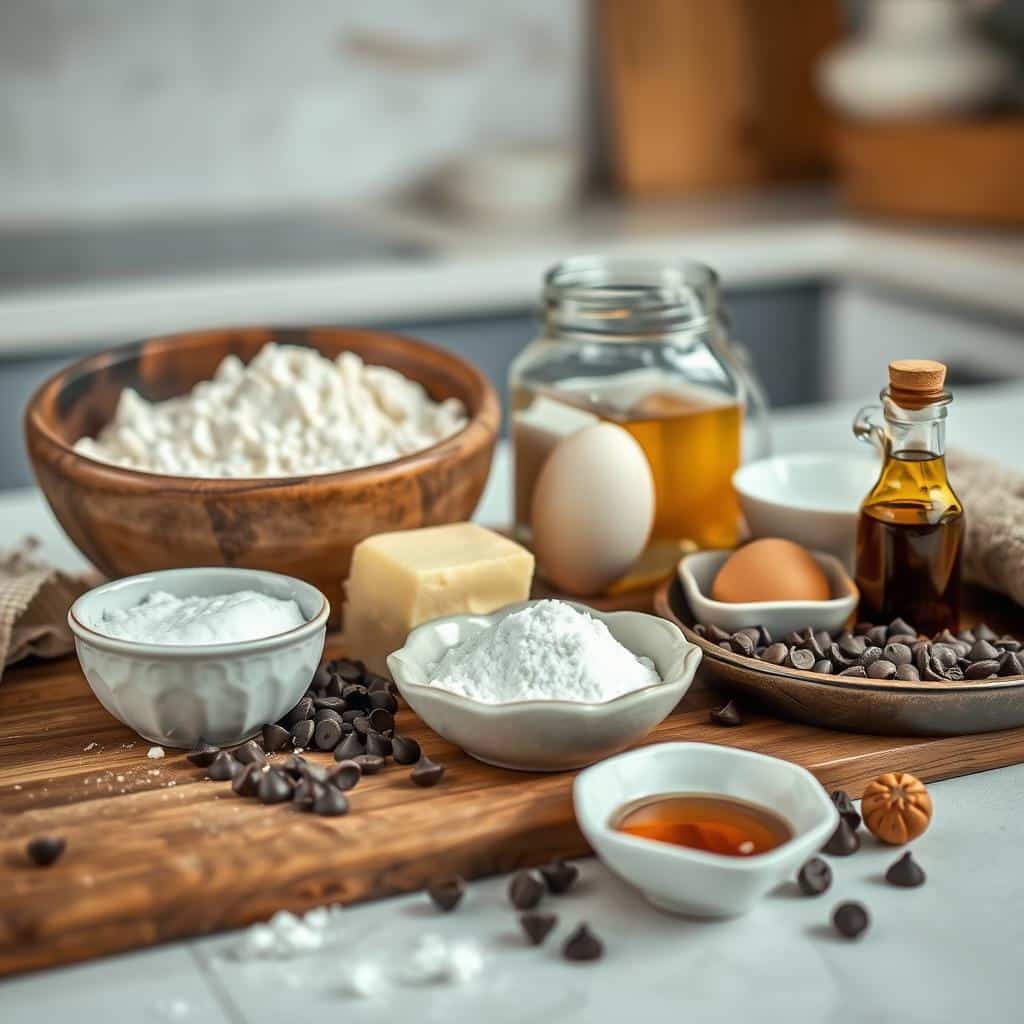The smell of fresh-baked chocolate chip cookies always made me happy. It brought back memories of warmth and comfort. Now, I’m on a quest to make the best homemade cookies, and I’m excited to share my journey with you.
In this guide, we’ll explore the Baking Illustrated method for the ultimate chocolate chip cookie. You’ll learn about the science behind the perfect texture and the key ingredients and techniques. Get ready to impress your loved ones with the most delicious homemade cookies ever!
Table of Contents
Key Takeaways
- Uncover the science behind achieving the perfect cookie texture through the Baking Illustrated method.
- Discover the essential ingredients and their optimal ratios for award-winning homemade cookies.
- Learn the must-have baking equipment and tools to ensure consistent, professional-quality results.
- Master the step-by-step dough preparation process for the ultimate in-home cookie baking experience.
- Explore the art of chocolate selection and incorporation for maximum flavor impact.
Why This Chocolate Chip Cookie Recipe Baking Illustrated Works
Making the perfect chocolate chip cookie is an art. The Baking Illustrated team has mastered it with their famous recipe. It’s all about the science behind the ingredients and techniques, creating a cookie that’s both crisp and chewy.
Science Behind Perfect Cookie Texture
The secret to the Baking Illustrated cookie’s texture is in the ingredients. The right mix of flour, sugar, and butter is key. This ensures the dough has the perfect moisture and structure, giving you that crisp-chewy contrast.
The use of brown and granulated sugar is also crucial. Brown sugar makes the cookies chewy, while granulated sugar adds crispness to the edges.
Key Recipe Advantages
- Perfectly balanced texture: crisp edges and chewy centers
- Optimal ingredient ratios for consistent results
- Detailed instructions for foolproof baking
- Versatile recipe that can be customized to personal preferences
By using the Baking Illustrated method, home bakers can make cookies as good as those from bakeries. The science-backed techniques and recipe advantages guarantee a remarkable treat every time.

Essential Ingredients for Award-Winning Cookies
Making the perfect chocolate chip cookies needs the right ingredients. Choosing the best flour and chocolate chips is key. Each part affects the cookie’s texture and taste. Let’s look at what makes cookies truly special.
The base of your cookies is the cookie ingredients. All-purpose flour gives them shape. Granulated sugar and brown sugar add sweetness and chewiness. Unsalted butter makes them creamy, and quality chocolate chips bring the chocolate taste.
| Ingredient | Purpose |
|---|---|
| All-Purpose Flour | Provides structure and consistency |
| Granulated Sugar | Adds sweetness and crispiness |
| Brown Sugar | Contributes chewiness and caramelized flavors |
| Unsalted Butter | Imparts a rich, creamy texture |
| Chocolate Chips | Provides the signature chocolate flavor |
Choosing and mixing these cookie ingredients carefully will help you make amazing cookies. Try different chocolate chips like semisweet or milk chocolate. Find the flavor you love.

“The key to a truly exceptional cookie lies in the quality and balance of its ingredients.”
Kitchen Tools and Equipment Needed
Baking delicious chocolate chip cookies is more than just a recipe. You need the right tools and equipment. From baking sheets to mixing tools, the right gear makes a big difference. Let’s look at the essential items and some helpful extras for baking success.
Must-Have Baking Sheets
The base of a great cookie is the baking sheet. Choose high-quality, heavy-duty sheets for even heat. Aluminum or stainless steel sheets are best because they’re durable and conduct heat well. Sheets with a raised edge help cookies keep their shape while baking.
Mixing and Measuring Tools
Accurate measurements are crucial in baking. Make sure you have reliable measuring cups and spoons, preferably metal or sturdy plastic. A strong mixing bowl, like glass or stainless steel, is perfect for mixing ingredients. A hand or stand mixer helps get the dough just right.
Optional but Helpful Equipment
- Cookie scoop: This tool ensures uniform cookie sizes for even baking.
- Parchment paper or silicone baking mats: These liner options prevent cookies from sticking to the baking sheet.
- Cooling rack: A sturdy cooling rack allows cookies to cool evenly and prevents soggy bottoms.
- Oven thermometer: Ensuring your oven is at the proper temperature is crucial for perfect baking instructions.
With the right kitchen tools and equipment, you’re ready to bake amazing chocolate chip cookies. They’ll impress everyone you share them with.
Understanding Cookie Chemistry
Ever wondered why chocolate chip cookies taste so good? It’s all about the chemistry in making the dough. Knowing the science behind baking cookies helps you get the perfect texture and taste every time.
The Role of Ingredients
Every ingredient in a cookie recipe is important. Cookie dough preparation mixes fats, sugars, proteins, and leavening agents. Butter or shortening add fats, while sugars help with caramelization and texture. Eggs hold the dough together, and baking soda or powder make the cookies rise and spread.
Temperature and Mixing Methods
The temperature and mixing methods affect the cookie’s structure and look. Tempering butter and eggs and mixing gently prevent gluten formation. This makes the cookie tender and soft.
“Understanding the science behind cookie baking is the key to consistently creating delicious, bakery-worthy treats at home.”
Achieving the Perfect Texture
The perfect cookie has crisp edges and a soft center. By controlling the cookie dough preparation process, you can get the texture you want. Whether it’s crunchy, cakey, or fudgy, it’s up to you.
- Crisp edges: Come from caramelizing sugars and losing moisture.
- Soft, chewy center: This comes from balancing fats, proteins, and leavening agents.
- Consistent thickness: This is achieved through proper cookie dough preparation and baking temperature.
By grasping the complex chemistry of cookie baking, you can make delicious, professional-quality cookies at home.
Step-by-Step Dough Preparation
Making the perfect chocolate chip cookie begins with the dough. It’s important to get the ingredients at the right temperature and mix them correctly. Each step is key to getting the right texture and taste. Let’s explore how to make cookie dough ready for baking.
Proper Ingredient Temperature
Temperature is crucial for your cookie dough. Make sure all ingredients are at room temperature before starting. This helps mix everything together smoothly. Let your butter, eggs, and other cold ingredients sit out for 30 minutes to an hour before baking.
Mixing Technique Tips
- Start by creaming the butter and sugars until light and fluffy, about 2-3 minutes.
- Add the eggs one at a time, beating well after each addition.
- Then, mix in the dry ingredients (flour, baking soda, salt) until just combined.
- Don’t over-mix, as it can make the cookies tough. Stop mixing when the dough comes together.
Dough Consistency Guide
The ideal cookie dough is slightly sticky but holds its shape. If it’s too dry, add a tablespoon of milk or water. If it’s too wet, add more flour. You want a dough that’s easy to handle and will bake into soft cookies.
“Dough consistency is key to achieving the perfect cookie texture. Pay close attention to how your dough feels and make adjustments as needed.”
Chocolate Selection and Incorporation
Choosing the right chocolate is key to making great chocolate chip cookies. You can go beyond traditional chips by trying different types. Options like bittersweet chocolate chunks or cocoa nibs add depth and texture.
Think about the cookie ingredients and the flavor you want. Darker chocolates, like 70% cacao, give a strong, complex taste. Milk chocolate is sweeter and creamier. Mixing both can create a balanced taste.
| Chocolate Type | Flavor Profile | Recommended Use |
|---|---|---|
| Milk Chocolate | Sweet, creamy | Complement other flavors, add texture |
| Dark Chocolate | Intense, bittersweet | Enhance chocolate flavor, balance sweetness |
| Cocoa Nibs | Nutty, crunchy | Provide textural contrast, amplify chocolate taste |
After picking the best chocolate, mix it into the dough carefully. Fold the chocolate chips or chunks gently into the batter. This way, every bite will have a rich chocolate taste.
The quality of your chocolate chips and how you mix them in can make a big difference. Try different chocolates and mixing methods to create your unique cookie.
Proper Cookie Dough Storage
Keeping your homemade cookie dough fresh is key for baking tasty cookies. Whether you’re baking now or saving dough for later, knowing how to store it is important.
Refrigeration Guidelines
For short-term storage, refrigerate your cookie dough. Shape it into a disk, wrap it in plastic wrap, or use an airtight container. Keep it in the fridge for up to 5 days. This keeps the dough’s texture and prevents it from drying out.
Freezing Methods
To enjoy your cookies longer, freeze the cookie dough. Here are some tips:
- Scoop the dough into portions and freeze them on a baking sheet. Once firm, move them to a container or bag. Store in the freezer for up to 3 months.
- Or, shape the dough into a log, wrap it, and freeze for up to 3 months. Just slice off what you need and return the rest to the freezer.
Properly stored cookie dough ensures your cookies are always perfect. Whether you bake them now or later, they’ll be delicious.
Baking Temperature and Timing
To make the perfect homemade cookies, you need to get the baking temperature and timing just right. This guide will help you master the baking instructions for your chocolate chip cookies.
Oven Temperature: The Sweet Spot
The best oven temperature for baking chocolate chip cookies is between 350°F (177°C) and 375°F (191°C). This temperature helps the cookies spread and get a golden-brown crust. It also keeps them soft and chewy inside. Try different oven temperatures to find what works best for you.
Baking Time: Balancing Perfection
- For regular-sized chocolate chip cookies, bake them for 10 to 12 minutes.
- Watch the cookies closely in the last few minutes. They should have lightly golden edges and still look a bit underbaked in the center.
- Adjust the baking time based on your oven’s efficiency and the size of your cookie dough balls.
Remember, the best baking instructions for homemade cookies can vary. It depends on your taste and your oven. Be patient, try different things, and enjoy making your own special chocolate chip cookies.
“The secret to the best chocolate chip cookies is in the precise baking technique.”
Troubleshooting Common Cookie Problems
Baking homemade cookies can be a fun experience, but sometimes, things don’t go as planned. Whether you’re new to baking or have years of experience, knowing how to fix common issues is key. We’ll look at solutions for two big problems: texture issues and cookies that spread too much.
Texture Issues Solutions
If your cookies are too hard or too soft, there are a few things you can do. For hard cookies, try baking them for a bit less time or at a slightly lower temperature. This can help them stay moist and soft.
If your cookies are too soft, baking them for a bit longer or at a higher temperature might help. You could also add a bit more flour to the dough.
Spreading Problems Fixed
Excessive spreading is a common problem when baking cookies. To avoid this, make sure your dough is well-chilled before baking. Letting it rest in the fridge for at least 30 minutes can help it keep its shape.
Also, using more brown sugar than white sugar can help. Brown sugar makes cookies thicker and chewier.
Understanding cookie chemistry and using these tips can help you bake perfect homemade cookies. With practice and a bit of experimentation, you’ll soon be making delicious, bakery-quality cookies every time.
Cookie Storage and Freshness Tips
Keeping your homemade cookies fresh is crucial for enjoying their taste and texture. Whether baking classic chocolate chip or trying new flavors, right storage is key. Here are some tips to keep your cookies fresh and delicious.
Room Temperature Storage
For a short time, store cookies at room temperature in an airtight container. This keeps them soft and chewy. Make sure to keep different types of cookies separate to avoid mixing flavors.
Refrigeration for Longer Shelf Life
For longer storage, the fridge is best. Put cookies in an airtight container or bag and chill them. They can stay fresh for up to a week, depending on the recipe.
Freezing for Maximum Preservation
Freezing is the best option for long-term storage. Pack cookies in an airtight container or freezer bag, removing air. Frozen cookies can last up to 3 months. To thaw, leave them at room temperature or warm them in the oven for a few minutes.
- If your cookies have lost their freshness, don’t despair. You can easily revive them by:
- Placing them in a paper bag or on a baking sheet and warming them in a 300°F oven for 5-10 minutes.
- Microwaving them in 10-second intervals until slightly softened.
- Sprinkling a few drops of water on the cookies and microwaving them for 15-20 seconds.
By using these simple storage tips, you can enjoy your homemade cookies for days, weeks, or even months. Savor every bite by keeping them at their best.
Conclusion
This guide has shown you how to make perfect chocolate chip cookies. You now know the science behind the ingredients, tools, and preparation. You can make cookies that will wow your family and friends.
Success comes from paying attention to the details. Make sure the ingredients are at the right temperature and mix them well. Try different chocolates, adjust the baking time, and add your own twist. This article has given you the tools to become a cookie expert.
Now, it’s time to start baking. Preheat your oven and get your ingredients ready. Enjoy the smell of cookies and the happiness of sharing them. Cookie baking is an art that brings joy and delicious treats.
FAQ
What are the essential ingredients needed for this chocolate chip cookie recipe?
You’ll need all-purpose flour, baking soda, and salt. Also, unsalted butter, granulated sugar, and brown sugar are key. Don’t forget large eggs and high-quality chocolate chips or chunks.
What kitchen tools and equipment are required to make these cookies?
You’ll need quality baking sheets and a stand mixer or hand mixer. Measuring cups and spoons, a cookie scoop or spoon, and an oven are must-haves. Optional tools include a food processor, parchment paper, and a wire cooling rack.
How do I achieve the perfect cookie dough consistency?
Use the right ingredient temperatures and follow mixing tips. The dough should be just right, not too dry or sticky. It should hold its shape but still be pliable.
What’s the best way to incorporate the chocolate chips into the dough?
Use a mix of chocolate chip sizes for the best flavor. Fold the chocolate gently into the dough. This prevents melting and ensures even distribution.
How should I store the cookie dough for best results?
Store the dough in the fridge for up to 5 days for short-term. For longer storage, freeze it for up to 3 months. You can freeze it as dough or in pre-portioned balls.
What are the optimal baking temperature and timing for these cookies?
Bake at 375°F (190°C). Cooking time varies from 8 to 12 minutes, depending on your preference. Keep an eye on them to adjust the time.
How can I troubleshoot common issues with the cookie texture and spreading?
Adjust baking time, oven temperature, or ingredient ratios for texture issues. For spreading, use the right ingredient temperatures and chill the dough. Adding extra flour can help too.
What’s the best way to store baked chocolate chip cookies to keep them fresh?
Store them in an airtight container at room temperature for up to 5 days. Freeze for up to 3 months for longer storage. Revive stale cookies by heating them briefly in the oven or microwave.

